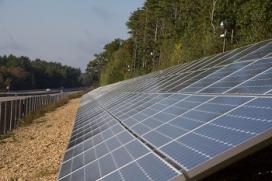Rights-of-Way Increasingly Being Considered for Innovative Uses
Some states are exploring the implementation of alternative energy technologies and alternative fuel facilities along publicly-owned highway rights-of-way (ROW) to curb the impacts of climate change and achieve other benefits. In a report prepared for the Federal Highway Administration (FHWA), Volpe researchers describe the state of practice in accommodating renewable energy technologies and alternative fuel facilities within highway ROWs. Solar applications along roadways and wind power applications at service areas and maintenance facilities are examples of projects that were examined. This report is intended to provide transportation agencies with information that will better enable them to consider the implications and evaluate the feasibility of implementing renewable energy and fuel options in the ROW.
The findings presented in this report are based on the review of the relevant literature and a series of interviews with stakeholders representing state highway ROW renewable energy and alternative fuel facility projects. The projects that are reviewed are in varying stages of completion and involve a range of technologies. A peer exchange convened among the interviewees and additional stakeholders supplemented the information collected during interviews. The lessons learned inform others seeking to pursue similar projects.
From a highway ROW perspective, there are considerable economic, ecological, legal, and political uncertainties. These uncertainties are related to whether or not accommodating renewable energy technologies and alternative fuel facilities can be practical highway land management practices.
According to Carson Poe, Volpe project manager and transportation industry analyst, "There are still quite a few unanswered questions and uncertainties facing the DOTs that are innovating in this area. The practice of using ROWs for alternative uses is quickly evolving, so there is a compelling need for states to share their lessons and talk about the best ways to overcome challenges."
The Volpe team synthesized information that was collected during the interviews to offer a set of observations and key findings that have implications for the success of similar projects.
Several of the Volpe researchers' findings are described here:
A supportive institutional environment is critical for the success of renewable energy projects in the ROW
Since alternative energy projects in the ROW are atypical projects for state DOTs, the process of securing internal leadership support can be challenging, but is critical.
A variety of public-private partnership models are used by states
Each of the renewable energy projects that the project team examined utilized a different business model, which, in turn, influenced the permitting process and contracting mechanism involved.
Siting concerns and requirements are a principal issue
In order to gain acceptance for renewable energy projects, project siting proposals should address specific transportation issues such as safety, reliability, durability, security, and avoidance of traffic flow disruptions.
Permitting processes vary by project
Each of the solar and wind energy cases the project team reviewed utilized a different permitting process to approve the use of the highway ROW: the utility permitting process, an airspace lease, a special use permit, and an easement.
Developing the lease agreements is a multifaceted process
Whether a project is permitted through the utility permit process, airspace lease, or special use permit, the DOT and the project partner will need to enter into a written agreement that outlines the applicable terms and conditions for the use of the ROW. A DOT must ensure that the written agreement used to permit renewable energy facilities in the ROW is adequate to protect the transportation facility and clearly defines the responsibilities of the parties regardless of the permitting process used.
A complete description of the findings, recommendations, and conclusions can be found in the full report.

In a recent report, Volpe researchers describe the state of practice in accommodating renewable energy technologies such as solar applications along roadways. This solar array can be found on State Route 44 in Carver, MA. (Volpe photo)
